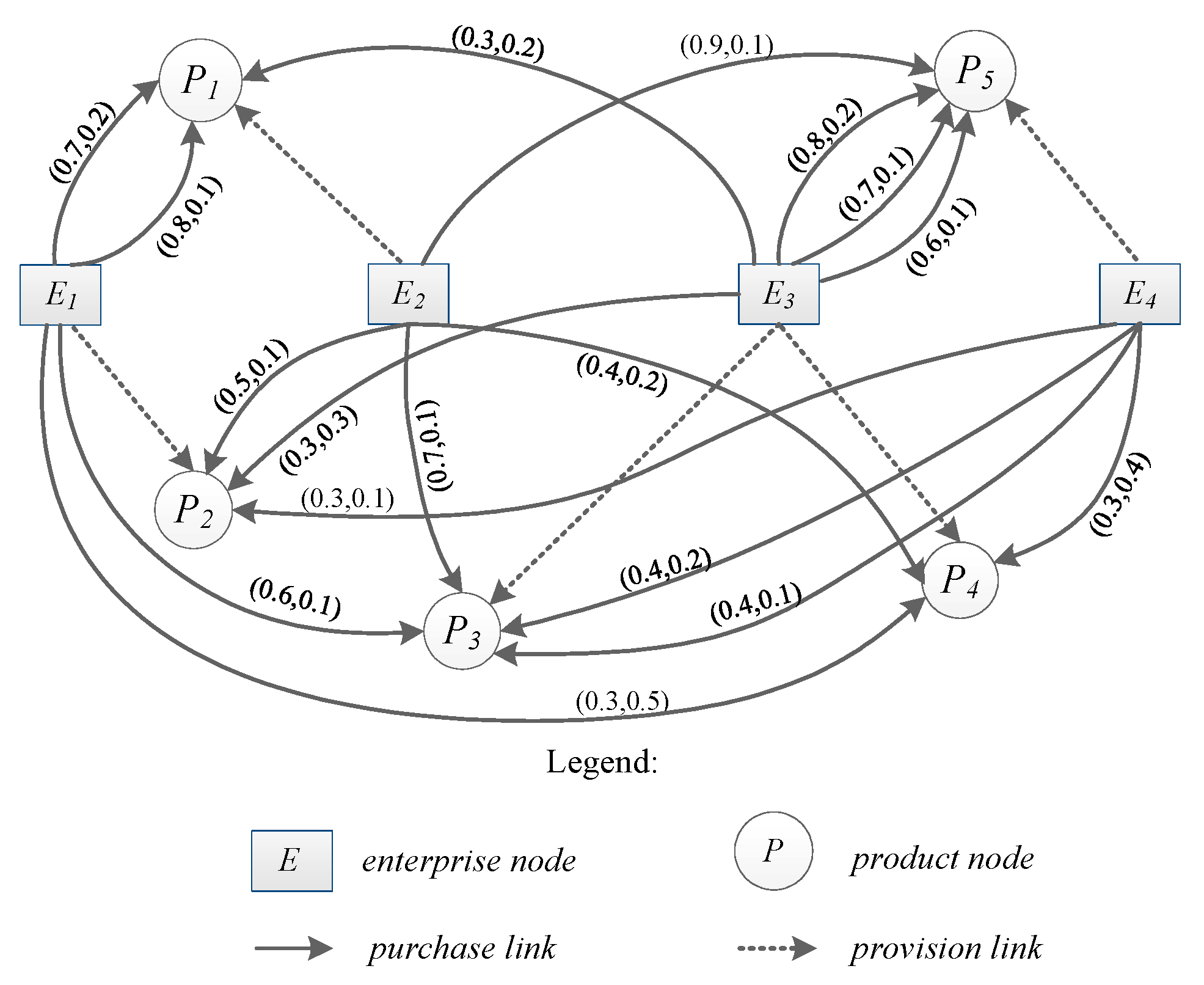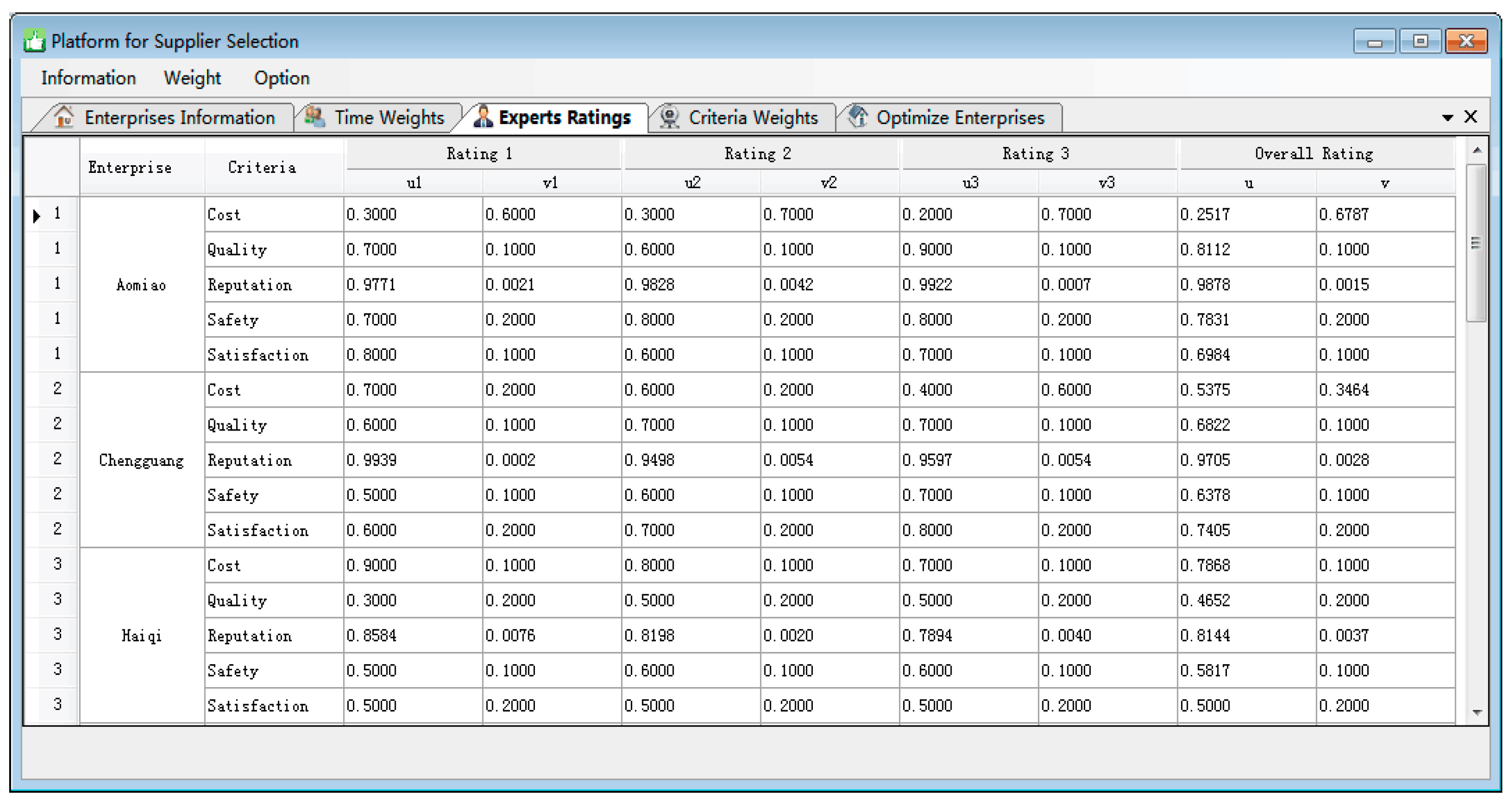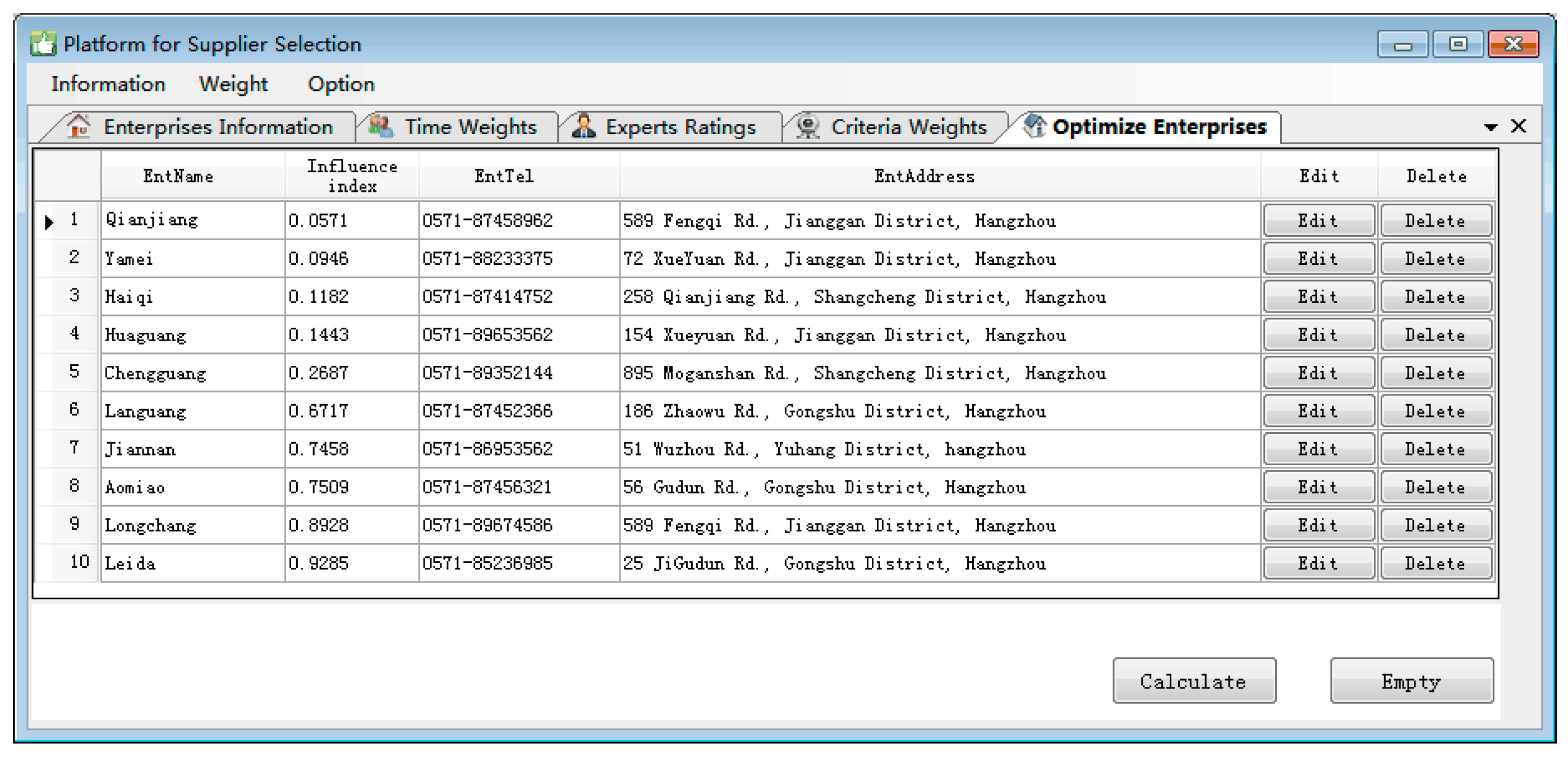The proposed approach for supplier selection contains five subsections: (1) notations, (2) using the IFS-HITS method to obtain the post-propagated reputation, (3) using the DIFWA operator to obtain dynamic attribute ratings, (4) using the IFEW method to obtain attribute weights, and (5) using the VIKOR to select an optimal supplier.
3.2. Using the IFS-HITS to Obtain the Post-Propagated Reputation
The HITS algorithm, which is famous for its excellent propagation characteristic, is often used to evaluate the quality of web pages [
28]. The quality of hub pages and authority pages can be propagated along the link direction and are mutually influential on the internet. Similarly, the reputation of a supplier can also be propagated along the link direction of the supply chain and be mutually influential in the supply chain network. Consequently, we apply the HITS algorithm to conduct reputation propagation of supply chain networks to obtain the post-propagated reputation of suppliers in this study.
In a supply chain network, there are two types of nodes. One of them is represented as enterprise, and another is represented as product which is provided by suppliers. A consumer enterprise may point to one or more products which is provided by suppliers through a provision link or purchase link. Each link carries a corresponding rating. According to the link structure of the HITS algorithm, the authority score can be considered as a reputation value of a supplier.
Figure 1 illustrates an example of a reputation-propagated supply chain network.
We assume that there is a directed network of supply chain
G = (
E,
P,
L), where
E and
P indicate the sets of nodes (including both nodes of consumer enterprise and product) and
L represents a set of links (including provision and purchase links). We build a rating matrix
, where
is the hub vector and
is the authority vector. Through iterative calculations, we obtain the hub value and authority value until the results converge (termination criterion). The iterative formulas of the traditional HITS algorithm are as follows [
28]:
Nevertheless, the traditional HITS algorithm can only process links in which the values are precise numbers and cannot process links in which the values are fuzzy numbers. Since an IFS has the powerful ability to express fuzzy information, we first apply IFNs to simultaneously express a positive rating (i.e., praise), a negative rating (i.e., criticism), and a hesitating rating (i.e., uncertainty) for every purchase link of the supply chain (provision links do not have ratings). Then, we incorporate IFNs into the HITS algorithm to extend the ability of processing fuzzy information to perform fuzzy reputation propagation.
For example, a purchase link from an enterprise to a product has a reputation rating
, which is shown as
RD = (
0.8, 0.1, 0.1). The first value
0.8 indicates a positive rating (equivalent to the membership degree), the middle value
0.1 indicates a negative rating (equivalent to the non-membership degree), and the last value
0.1 indicates an uncertain rating (equivalent to the hesitancy degree). In order to simplify the calculation, we omit the third value according to Equation (2).
Table 1 shows the rating matrix
corresponding to the supply chain network in
Figure 1.
In
Table 1, S denotes the start point, E denotes the end point, edge denotes the number of links from the start point to the end point, and rating denotes the reputation rating given by
Ei to
Pj. Because the HITS algorithm cannot be used directly to calculate the raw ratings under intuitionistic fuzzy environment, the original data must be preprocessed. Thus, the following three types of special ratings are discussed. (a) If enterprise
Ei provides product
Pj, then the matrix elements
is equal to null because the enterprise cannot evaluate the products which can provide by themselves to avoid subjective rating. (b) If enterprise
Ei has not purchased product
Pj (i.e., rating is zero in
Table 1), then the rating
is equal to the average value of all purchase ratings from other enterprises to product
Pj, i.e.,
(inspired by the intuitionistic fuzzy average operator [
27]). (c) If enterprise
Ei purchases product
Pj repeatedly, then the rating
is equal to the average rating value of all purchase ratings from enterprise
Ei to product
Pj, i.e.,
. The above three types of special ratings can be summarized by the following equation:
The three kinds of special ratings can be calculated using Equation (10); the final results are displayed in
Table 2.
Considering the drawbacks of the traditional HITS algorithm, we propose a new method (i.e., IFS-HITS), which combines IFSs with the HITS algorithm to obtain post-propagated reputation values. The iterative computation process is shown in Equations (11)–(14):
In addition, the formulation for the elements of
and
is as follows:
According to Formulations (11) and (12), we can compute the hub values of enterprise node. In addition, we can use the following formulas to calculate the authority value.
The formulation for the elements of
and
is as follows:
According to Formulations (13) and (14), we can calculate the authority values of product node.
The termination conditions are different from those of the standard HITS method. The termination conditions standard HITS algorithm is the result of last two iterations in approximation, i.e., the difference of or among all elements is less than a defined value. Herein, denotes hub vector, denotes authority vector, and t denotes the iteration times.
Because the IFN is different from the operation law of precise number, the termination condition is also different. Thus, we use Equation (4) to modify the termination condition. According to Equation (4), we firstly compute the accuracy function value of and for each vector element. Then, we can compute the accuracy function value of and for each vector element. Finally, if the difference of or among all elements is less than a defined value, then the termination condition is reached. In this study, we set that the difference of termination condition is 10−6. Because we need to obtain reputation values of products, the termination condition only computes the difference among the accuracy function values of each element for authority vector.
Based on IFS-HITS method, we take the five products nodes and four enterprise nodes as example to compute all the reputation values of suppliers. The original reputation rating matrix and the preprocessing rating matrix are listed in the
Table 1 and
Table 2. Let us assume that the original authority vector of the five product nodes is
. We assume that original reputation values for product are regarded as the original reputation values for supplier. According to Equations (10)–(14), we can compute the reputation values of overall suppliers. The ultimate result, namely the reputation values of suppliers in the first year, can be obtained as follows (all values are rounded off to four decimal places):
where
(
s = 1, …,
S) represents the
sth year reputation value of five products which provided by five different suppliers. However, the computation rules of IFNs are different from those of precise numbers. In order to compare the trust values, we sort the values in decreasing order using accuracy and score functions (see Definition 3). Then, the maximum value that represents a supplier with the highest reputation value is chosen as the best one. Accordingly, we determined that supplier 5 is the best candidate supplier with respect to reputation.
3.3. Using the DIFWA to Obtain the Attribute Ratings
It is difficult to accurately determine the attribute ratings using a group of static values. In fact, attribute ratings of suppliers always change over time. For example, despite a supplier having an extremely low score for their reputation degree in former years, it has constantly enhanced their service ability since then. Therefore, the reputation value of the supplier is improved in recent years. Dynamism is an important factor that influences the reputation degree of a supplier. It is reasonable to introduce the DIFWA operator to obtain dynamic attribute ratings from different periods (inspired by Reference [
36]). Next, we describe the DIFWA operator.
In actual problems, some data use IFNs to demonstrate criteria ratings that are collected from different periods. Therefore, Xu et al. [
37] proposed a novel operator called the DIFWA operator to aggregate information from different periods.
Definition 5. Letbe a collection of IFNs collected from S different periods s = 1, …,
S, and letbe the weight vectors of different periods s = 1, …,
S with,s = 1, …,
S,. Then, we calla dynamic DIFWA operator. According to Definition 5, we can rewrite this equation as follows [
37]:
The time weight and the length of time can be defined based on the real situation. As time passes, the time becomes closer, which means the weight increases.
For example, we consider three groups of values in the last three years with different time weights to better assess the reputation degree. Let
be the dynamic time weights for the three years, the original authority vector of five suppliers are
and
for the remaining two years. Using the proposed IFS-HITS method, we can calculate the reputation values of the remaining two years for suppliers shown as follows:
Using Function (16), we acquire the following overall dynamic reputation ratings:
According to the final outcome, we determine that supplier 1 is the best candidate supplier with the highest reputation degree. In this study, other dynamic attribute ratings also can be acquired by the DIFWA operator in a similar manner.
3.5. Using VIKOR to Select Optimal Suppliers
Opricovic et al. [
40] developed a method called the VIKOR method to determine a compromising solution by sorting a series of options. The main idea of this method should be as close to a positive solution and as far from a negative solution as possible. The primary steps of the VIKOR method are as follows [
41]:
(1) Utilize the DIFWA operator. We first use the DIFWA operator (see Definition 5) to aggregate all the intuitionistic fuzzy ratings into an intuitionistic fuzzy decision matrix
D, which is given by
where
M denotes the total number of suppliers and
N denotes the total number of criteria.
(2) Determine a positive solution and a negative solution. As the name implies, the positive solution is the best value, and the negative solution is the worst value. If the attributes are benefit criteria, a greater preference value is better (see the below Formula (19)). If the attributes are cost criteria, a smaller preference value is better (see the below Formula (20)). Under the corresponding evaluation criterion
,
and
denote largest and lowest IFNs, respectively. The corresponding formulas shown as follows:
(3) Calculate the group utility value and the individual regret value. We can compute the group utility value
and the individual regret value
using the following formulas:
According to the characteristics of IFNs, we modify the above formulas (inspired by Reference [
36]) and choose the Hamming distance to calculate
and
as follows:
(4) Compute the influence index
of each solution.
can be computed as follows:
where
,
,
, and
. Here,
v denotes the weight of the maximum group utility; specifically,
v > 0.5 denotes the decision of the majority of people,
v < 0.5 denotes the minimization of individual regrets, and
v = 0.5 denotes a consensus. Herein, we set the value to
v = 0.5.
(5) Determine a compromising solution. We rank the compromising solutions in ascending order of the influence index . The enterprise with the lowest influence index is considered the optimum supplier.
Using the above methods, we select the optimum supplier.








